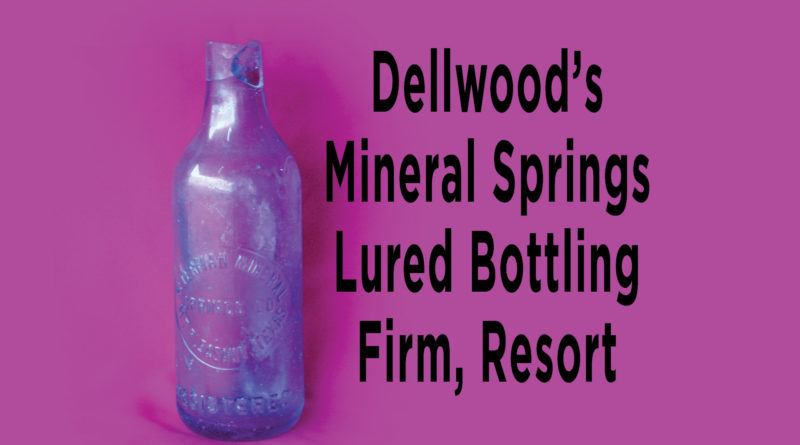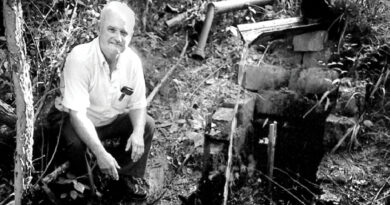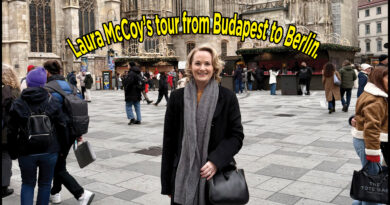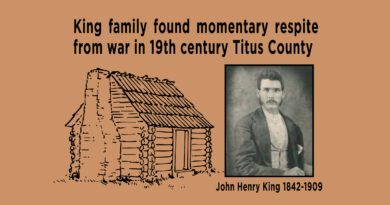Dellwood’s mineral spring’s lured bottling firm, resort
Some of the names are lost, like mists burned away in morning sun. Peterman, Wolfe . . .
Others have changed meaning. Time was, Vivian Fowler was a girl left a widow too soon. Today, Vivian Fowler is an elementary school.
It was 1916. Vivian Florey married Clyde Fowler. The newlyweds left for Fort Worth where he died two years later in the flu epidemic of 1918.
With their infant son, Henry Florey Fowler, Vivian returned to the security of the Florey home, a name once associated with the pinnacle of dreams for Mt. Pleasant.
Listen.
Like the first of the anglo settlers to build here, the Florey family came, drawn by dreams ignited by the legendary springs that spawned the resort its developers named Dellwood.
Now it’s a city park.
It rose from a contest to name the resort built sometime between 1906 and 1908. Dellwood Park.
Until then, says Webster, a dell was a small, secluded valley, usually a wooded one and the name of the person who won the contest, named the ancient valley on the outskirts of what’s become the town, has been long-since lost. That romance noted, here’s a story drawn from fable and gaping records.
Some say Benjamin Gooch was an Indian, some say he was half white with an Indian wife, wrote local historian Traylor Russell.

Whichever, he was a frontiersman whose paper trail picks up on the Texas frontier in the present-day region of Williamson County, February 1836, a month before Texas ripped itself from the colonial clutches of Mexico as an Independent nation. San Jacinto. The Alamo.
Eager for settlers to build wealth in the new nation, the republic government doled out land to its pioneers. A widow, Elizabeth Chism was entitled to a section of land. In 1839 she married Mr. Gooch, who sold his land west of Clarksville and with his new bride moved to her 640 acres in Titus County.
Legend says they lived among the Indians and archeological studies conducted in advance of U.S. 49 projects have time and again unearthed wealths of Caddo Indian artifacts along Swanno Creek. The couple made their first home within a stone’s throw of the creek at Gooch Springs, when this was Red River County.
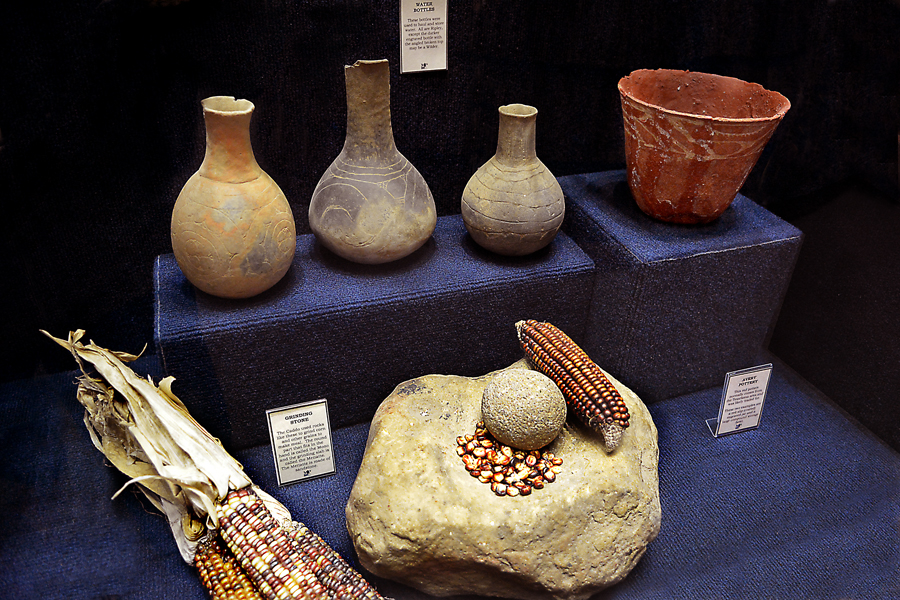
In 1840, Mr. Gooch served as county surveyor of Red River County and it was in that year that he and Elizabeth built their home at Dellwood. They named the stream flowing through the dell Gooch Branch, Mr. Russell wrote, but that name too, is gone.
Five years later, the Republic of Texas became the 28th state of the Union. Elected to serve in the first state legislature from Red River County, Representative Gooch submitted legislation carving Titus County from Red River County.
By the late 1840’s, he was gone, having moved back to Williamson County, where he was elected County Clerk.
Titus County’s deed records were destroyed when the courthouse burned in 1875 but in the 1890’s the land where odd springs flowed into Gooch Branch was sold to one Jessie Reed, who first envisioned development of a resort.
He put together an advertising campaign, Mr. Russell wrote, referring to the area as “The Iridescent Springs.” A cafe was built alongside the stream and Mr. Reed built a row of “camp houses” for tourists.
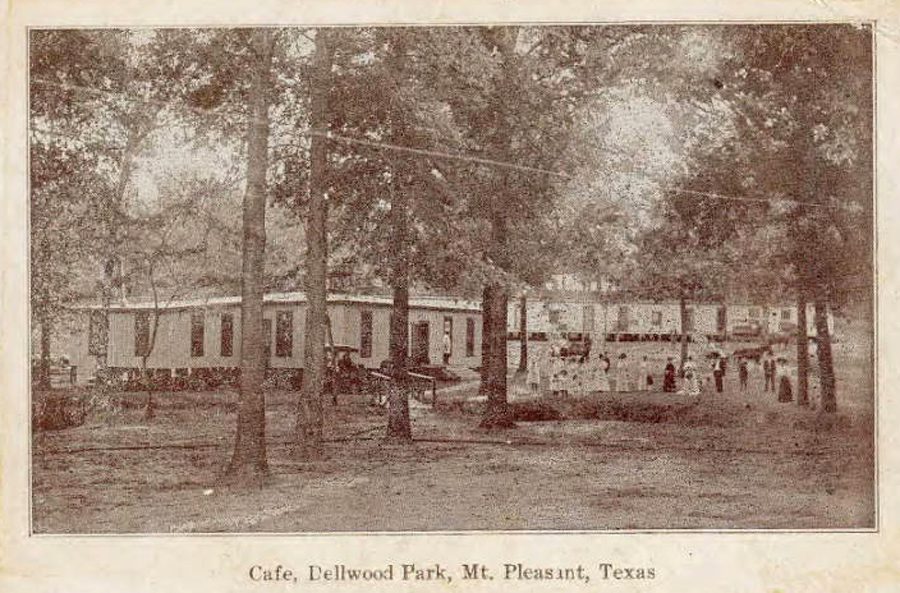
“Come and sleep where the red man slept, and drink the waters the red man drank,” his earliest print media ads beckoned.
There were a number of springs, some flowing red water, some blue and some crystal clear, the legend says.
“The colored waters coming from the springs gave Mt. Pleasant quite a boom in the late 1890’s,” Mr. Russell wrote, “in a period when people suffering from gout, arthritis, rheumatism” and even tuberculosis were ready to drink any water or take any medicine that was represented to them as being something that could relieve their suffering.
The presence of abundant Caddo Indian artifacts in the park area added a certain flavor, almost a legitimacy to the legend of the curative powers of the mineral springs.
Mr. Reed owned 120 acres and worked trying to sell lots that then were on the outskirts of Mt. Pleasant. His venture ultimately failed and not long after the turn of the century, his land was sold on the courthouse steps to H.W. Peterman for $1,600.
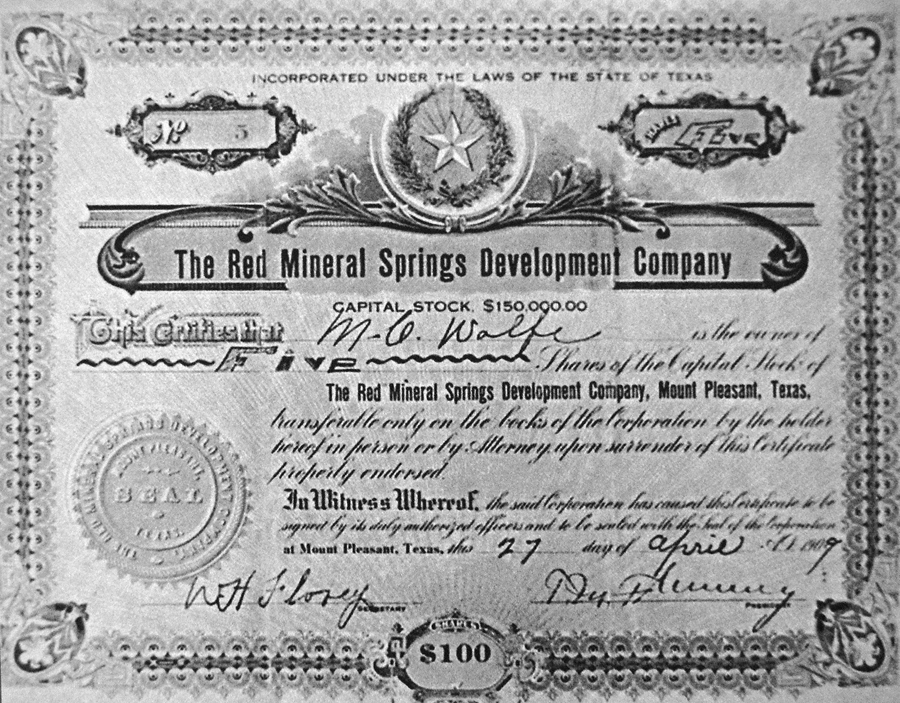
Peterman and Sons began bottling water from the springs and a number of local medical doctors wrote glowing testimonials of its “restorative properties” saying the water cured diseases of the kidney, bladder, stomach and intestines.”
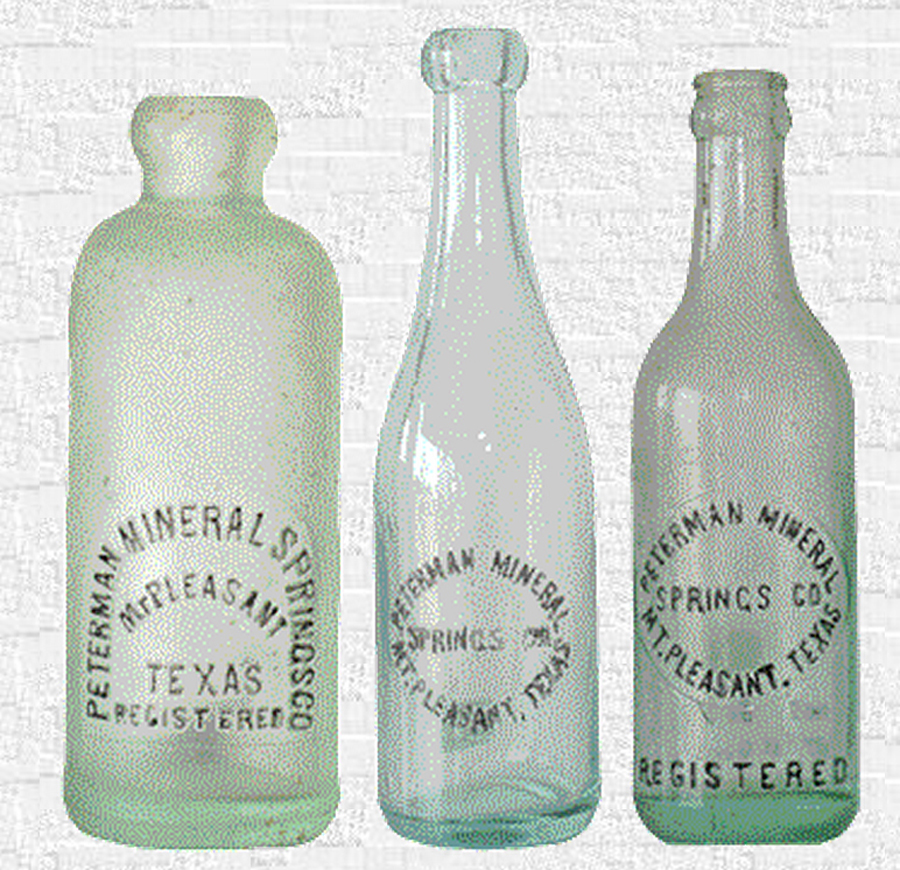
Whether or not he did well in the bottled water business, Mr. Peterman hit a lick in 1907 when he sold his property to W.H. and Spencer Florey, of Overton, Dr. T.M. Fleming and Spill Brown of Mt. Pleasant for $15,000.
Widowed in 1902, W.H. Florey moved here in 1908 and construction of the Dellwood Resort began.
His daughter, Vivian Florey-Fowler, remained with relatives in Overton, but writing of the park in 1976, the widow renouned as a local educator remembered vacationing at the springs even before the Red Mineral Springs Development Company began building the resort.
While Mr. Russell dates the opening of the Dellwood Hotel at 1908, Mrs. Fowler wrote that it opened in 1910. What isn’t argued about is the grandeur of the place.
Built in the shape of a Y, the two-story 80-room hotel wrapped around the crest of a hill overlooking the park. The first floor included a dining room and lobby and a large parlor on the second floor was available for balls and receptions. Water from the springs was piped to fountains in the lobby — one for red water, a second for blue, a third crystal clear.
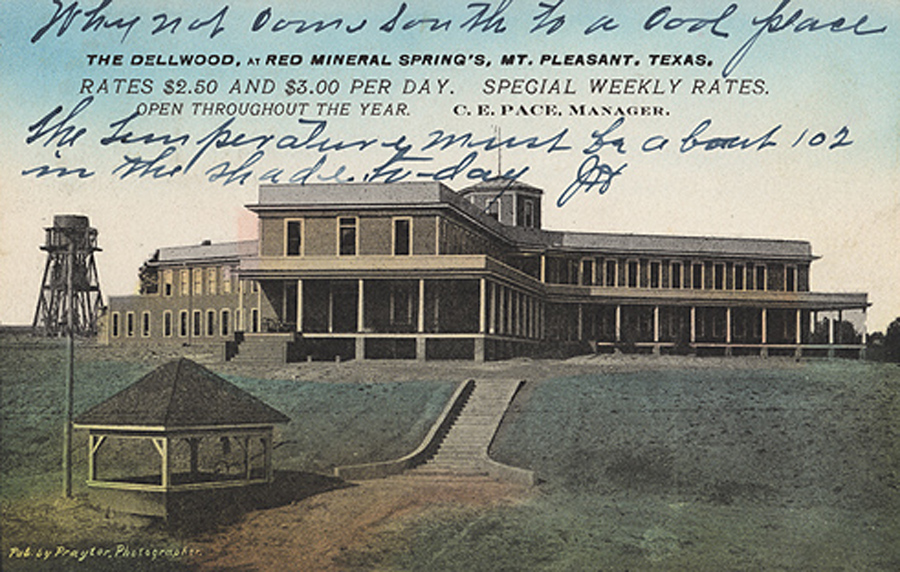
Before there was electricity or running water in the town, the Dellwood Hotel had its own generating plant, water and sewage systems.
A pavilion at the foot of the hill dropping toward the stream featured a bowling alley; in the flats to the southwest there was constructed a huge swimming pond, “one hundred feet wide and one hundred yards long,” Mrs. Fowler wrote.
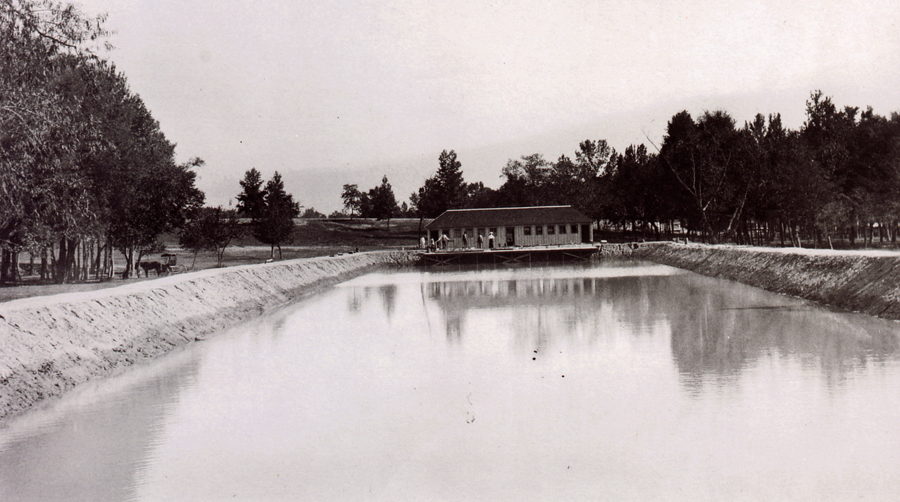
Evenings, electric lights lighted walking paths through the park and a narrow gage rail line was built from the park into the town, a distance of just over a mile. A motorized trolley ran along the rail. When the motor “retired,” Mrs. Fowler wrote, it “became a mule-drawn car.”
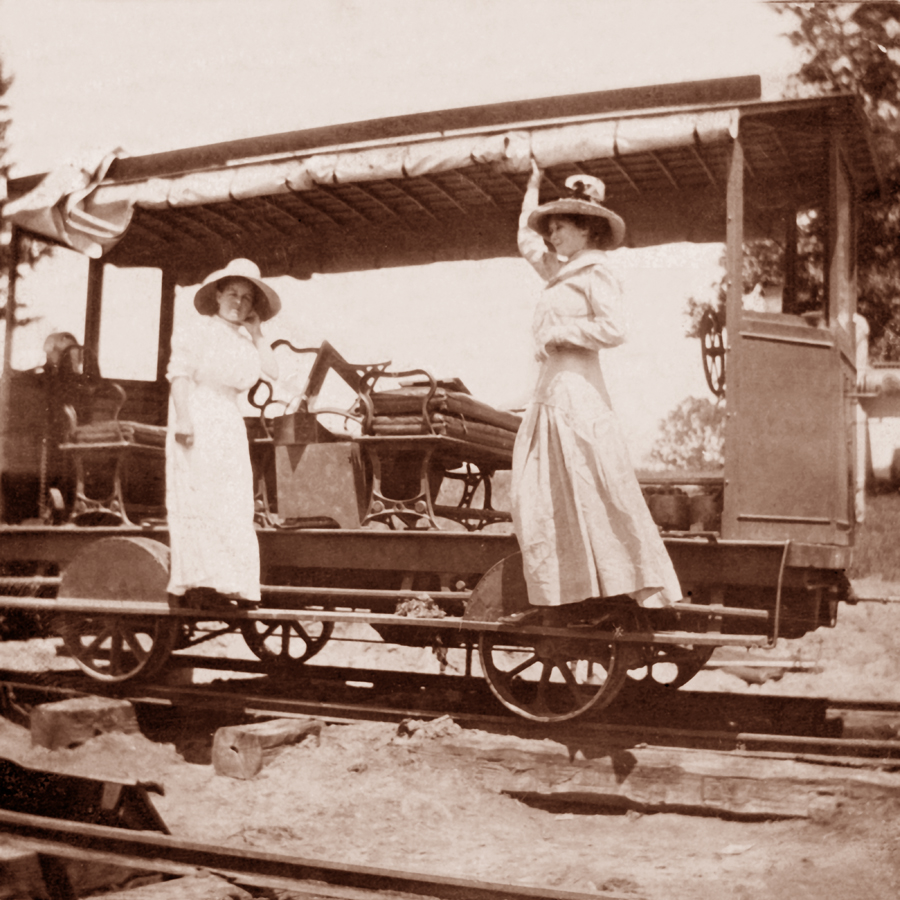
In addition to the backing of the local medical establishment, there were testimonials of the curative powers of the water from the springs.
At the time the resort opened, B.H. May, who lived near the springs, said he had come 15 years prior from Tennessee, and that he had suffered from “constipation and bleeding piles,” and that he had been so afflicted for 35 years without obtaining any relief, but after drinking from the springs for nine months he was sound and well. Another man said he had come to the springs to lame with rheumatism that he could not step over small objects, but after using the water for one month, he was cured and able to plow all day. A Mrs. Elliott said that she had arrived at the springs so afflicted with kidney and bladder trouble that she was “absolutely helpless,” but within a week she felt better and after three months, she was “entirely well.”
If not for health, enjoy romance.

“Seats and swings are available throughout the park,” the developers said, “and the tired man or woman or the fellow with his best girl may find a place to unload his troubles in fresh pure air; and if the dear girl faints, she may fall on the grassy lawn under a beautiful shelter provided by nature, and be cared for until the shock is over . . .”
Even so, the Red Mineral Springs Development Company was a short lived dream. Mr. Russell says the hotel closed following a Confederate Veterans reunion in 1910.
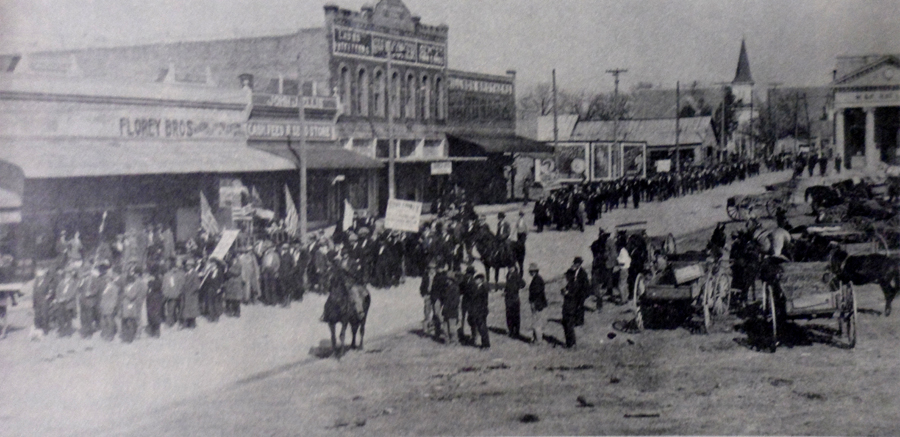
“Several thousand people came and camped in and around the park, so many that on the third day they had simply consumed all of the available provisions in the city, and the convention broke up hungry.”
Following the summer of 1910, Mr. Russell says, the hotel ceased operation and a year later it was leased to Mr. A.C. Spear, who came from Dallas to open the Spear Academy as a boys’ school. The academy failed after two years.
The grand hotel became a boarding house, operated first by a man named Isaac Mooreland and then by William Florey, Mrs. Fowler’s father.
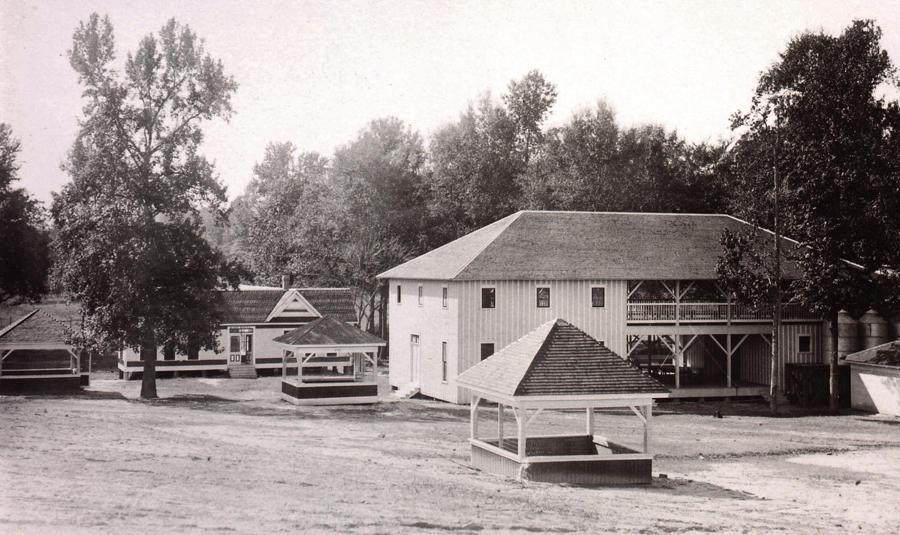
In 1913, just north of the old hotel, William Florey began construction of a colonial home like something from Gone with the Wind.
When the home was completed in 1914, after living years with relatives back in Overton, Vivian moved to Mt. Pleasant to live with her father. At about the same time he married again.
Vivian left when she married Mr. Fowler two years later; in 1918, she returned, a young widowed mother, and again moved into her father’s home and began teaching at West Ward school. She never remarried — in fact, she never accepted another suitor after her husband’s death.
Her son, Spencer Florey Fowler, married and moved to Houston.
After the hotel closed, William Florey and his brother, Ebenezer (E.B.) Spencer Florey, opened a general mercantile store.
Later E.B. Florey opened his own store.
In 1964, Vivian Fowler retired after teaching third grade for nearly 50 years — West Ward School was named in her honor.
Following the death of Dr. Fleming, one of the original investors of the Red Mineral Springs Development Company, his widow married a Dr. Lacy of Pittsburg. At some time prior to 1949, Dr. and Mrs. Lacey and the Florey brothers divided the land in Dellwood park evenly, Mrs. Fowler wrote.
Mrs. Lacy acquired what was later developed as Park Hills Addition by her daughter, Mildred Fleming Larkin, and her husband, M.E. Larkin.
William and Spencer kept the land where the park is today. When William Florey gave land for the right of way for the Daingerfield Highway (U.S. 49), the proposed road separated his house from his barn, which was in the park area. Mrs. Fowler remembered that the city agreed to make an underpass for his cows; when the road was built, the underpass wasn’t. So, each morning, her father herded his cattle across the road to graze in the park, and each afternoon, he brought them back across the road.
In 1910, a third Florey Brother, T.R. (Tull) Sr. came to Mt. Pleasant with his wife, Alma, and three young children. They moved first into the Dellwood Hotel.
In 1911, the three brothers opened Florey Brothers General Merchandise store on the west side of the square.
When that business dissolved, Tull worked in the Lilienstern Brothers store for a few years before opening a feed and grocery store in the business district on West Third Street.
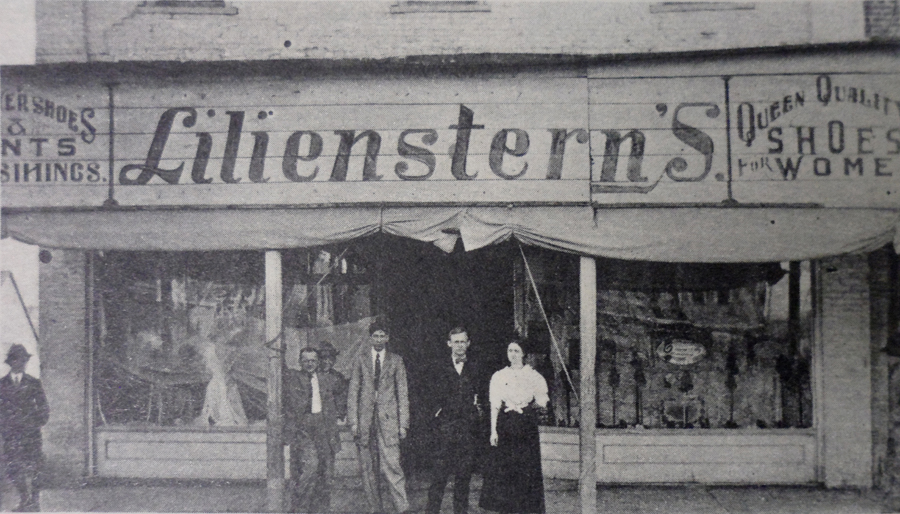
Tull Senior died in 1943. His brother, William, died in 1956 and Mrs. Fowler lived in the old Florey home until shortly before her death in 1984.
Tull Sr. and his wife, Alma’s three children were T.R. “Tull” Florey, Jr., Mrs. A.T. Blackshear and Mrs. Kathryn Harling.
In 1928, Tull Florey Jr. opened his law practice in Mt. Pleasant. He served as county judge and as municipal judge.

In 1948, on the occasion of Mt. Pleasant’s 100th anniversary, as reported in The Mt. Pleasant Times Review, the newspaper lamented the passing of Dellwood Park as a local resort.
“Picture, if you will,” the Times invited, “the grandeur of old Dellwood, the opportunities it afforded for play and relaxation, the happy throngs that once gathered there, and you will not wonder that there are many here today who want it as a modern city park.
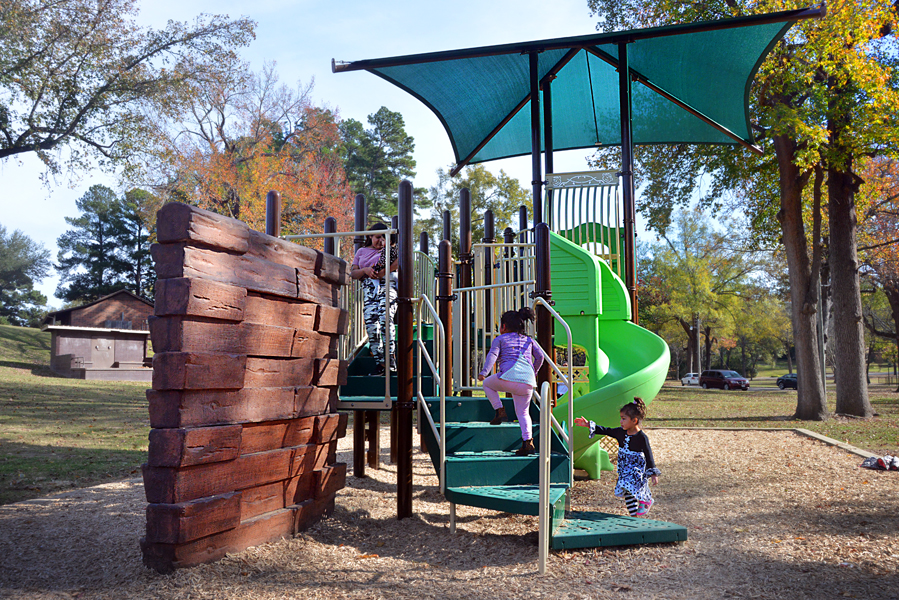
In 1949, for a nominal amount, Mrs. Fowler wrote, the Florey brothers sold the park to 1st National Bank President A.G. Daniel, as a trustee for the city.
In 1951, title to 45 acres where Dellwood Park lies today was conveyed to the city for just over $3,000.

